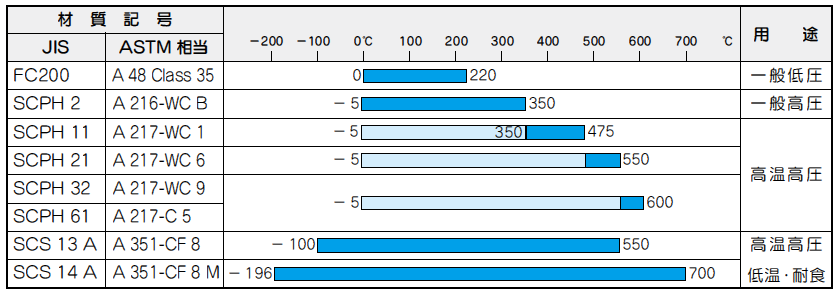Valve Body Materials
The table below is a metric for the selection range based on temperature. Since in reality the pressure can have a major effect, when selecting materials, please refer to the JIS and ASME/JPI temperature/pressure stage tables.
Temperature/Pressure Stage Tables (pdf)
 Note 1: For the materials code JIS, ASTM, and DIN standard comparison tables, refer to the PDFs below.
Note 1: For the materials code JIS, ASTM, and DIN standard comparison tables, refer to the PDFs below.
Note 2: ![]() Shows the recommended range.
Shows the recommended range.
Note 3: If for low temperature, use either SCS13A or SCS14A.
Various Rated Targets Table (pdf)
◎ Selection Standards for Valve Body Materials
To ensure that the control valve can be used in satisfactory conditions spanning long periods, first we need to clearly grasp the usage objectives and conditions, and select a material for the valve main body and trim. Here, the basic points that we need to consider for selection are listed below.
|
1. Are there legal restrictions or specific standards? |
Note: For details about the corrosion resistance of metal materials, refer to the PDF listed below.
Metal Materials Corrosion Resistance Table (pdf)
■ Materials for High Temperatures
The control valve receives complex stresses in the piping, and also must be able to withstand loads due to fluid pressure and temperature. When stress is applied to plain carbon steel for long periods at high temperature, its mechanical properties are degraded and the creep phenomenon occurs.
Therefore, if severe high-temperature conditions are added, first of all, problems arise with the material’s strength, including creep strength, corrosion resistance, and organizational stability. Materials capable of responding to these problems at high temperature are used in alloy steel, as Cr, Mo, Ni, or other additives. Cr improves acid resistance and corrosion resistance at high temperatures, while Mo adds to creep strength, and Ni improves shock resistance, among other effects.
The maximum usage temperature of forged steel parts in valve main bodies for high temperature and high pressure use, for the standard material carbon steel forged steel parts SCPH2, it is 350°C, for 0.5% Mo steel SCPH11, 500°C, for Cr-Mo steel SCPH21, 550°C, and for SCPH32, 61 reinforced with Cr, it is 600°C. At even higher temperatures, austenite stainless steel offers still higher resistive force to the high-temperature creep and graphitization phenomenon, so that SCS14A can be used at up to 700°C, with additives of Cr 21%, Ni 12%, and 2.5% Mo.
■ Materials for Low Temperatures
The most important problem in low-temperature materials is low-temperature brittleness. Ordinarily, in metal materials at low temperature, while hardness or tensile strength increases, toughness is lost and the shock value goes down. In particular, in ferrite metals this phenomenon is quite drastic, while austenite metals do not show any low-temperature brittleness. An effective response to this low-temperature brittleness, as seen with austenite stainless steel, is to add in Ni, Mo, or Cr, etc.
The martensite starting point (the temperature where a part of the organization becomes martensite) for SCS13A is -114°C, and for SCS14A, -202°C. To avoid the occurrence of distortion during low-temperature use, the use of SCS13A is recommended at -100°C or higher, and of SCS14A at -100°C to -196°C.
■ Corrosion Resistant Materials
Since corrosion often occurs due to a combination of various factors, such as the fluid type, properties, pressure, temperature, concentration, flow velocity, and usage environment, tests under actual conditions are difficult to perform, and adequate studies based on corrosion tables are necessary. Corrosion-resistant materials include stainless steel, hastelloy B and C, titanium, and other metal materials, as well as non-metallic materials that can exhibit corrosion resistant properties not found in metals, such as plastics, glass, fine ceramics, rubber, and PTFE, and other materials used for the inner walls of metallic valve main bodies, the lining, and coatings, etc.
■ Cavitation and Flashing Resistant Materials
In general, the corrosion that is often a problem at power plants, etc., can advance sharply when used in high-temperature water or under high pressure differentials, due to cavitation or flashing, leading to a phenomenon known as cavitation erosion.
Materials capable of withstanding these conditions that can be used include Cr-Mo steel with additives of Cr, Mo, and Ni, etc., and 18-8 austenite stainless steel. In particular, stainless steel has more than 10 times the wear resistance of carbon steel, and is superior as an anti-erosion, anti-corrosion material.
Caution is a necessity, since cavitation and erosion most often appears as damage to the trim, more than to the valve main body.

|
Types of Control Valve Corrosion/Erosion
1. Chemical Corrosion |
